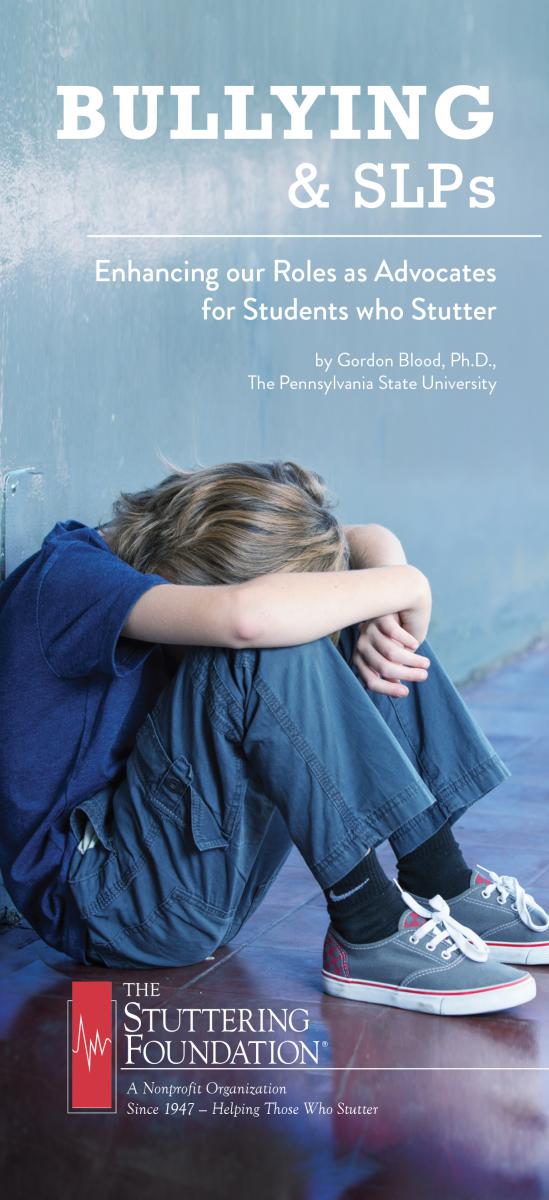By Gordon W. Blood, Ph.D.
Penn State University

 Every child has the right to ride a bus, use a restroom, participate in classes, walk the hallways, eat their lunches, and walk home after school in a “safe” environment. Speech-language pathologists (SLPs) working in schools with children who stutter may have victims of bullying on their caseloads. These student-victims may feel most comfortable turning to SLPs for help during one-on-one treatment sessions to discuss these types of experiences.
Every child has the right to ride a bus, use a restroom, participate in classes, walk the hallways, eat their lunches, and walk home after school in a “safe” environment. Speech-language pathologists (SLPs) working in schools with children who stutter may have victims of bullying on their caseloads. These student-victims may feel most comfortable turning to SLPs for help during one-on-one treatment sessions to discuss these types of experiences.Bullying is a form of aggression with three primary features: a) intent to do harm, b) repetition of the bullying behavior, and c) a power imbalance between the bully and his or her victim (Olweus, 1993). Bullying is an epidemic in our schools, creating negative and damaging effects on students’ academic achievement, self-esteem, physical health, and social relationships. The research clearly shows that it leads to increased anxiety, depression, alienation, long-term negative consequences and in severe cases suicidal thoughts and actions (Arseneault, Bowes, & Shakoor, 2010).
There are four main characters in this cycle of aggression: 1) bullies, 2) victims, 3) bully-victims and 4) bystanders. It would be great if everyone wore labels, but they don’t. Bullies are not only the “bigger kids” using foul language with internalizing and externalizing problems who are academically challenged. They are the popular girls, the class leaders, the student-athletes, and the teacher’s favorites. They include the students who display great difficulty learning and sometimes the most gifted children in the school.
Victims appear to be more sensitive, weak, shy, and quiet. They may display poorer social skills/relations and uneasiness in conversations. Victims may display one or more of these characteristics. Victims tend to be described as either passive (non-responsive to the aggression) or provocative (responsive to the aggression). Passive victims make-up about 80% of victims.
Provocative victims are also referred to as bully-victims. Bully-victims strike back at the bully with aggression and often begin to use coping responses which mimic bullying behaviors toward others.
The final character in this violent cycle is the bystander. These students are needed by the bully to witness the power struggle. Bystanders take on divergent roles of: a) cheerleader/supporter for the bully, b) protector/defender for the victim or c) silent on-lookers, lost, fearful and not knowing what to do. Bullying impacts all the children in a school.
Bullying commonly reported in the literature includes four types: physical (e.g. hitting, pushing, kicking, beating), verbal (e.g. put-downs, abusive language, name-calling), relational (e.g. spreading rumors, exclusion from social groups, peer discrimination), and cyber bullying (e.g. texting, tweeting, using technology to anonymously inflict aggression without personal contact). Children with disabilities are more vulnerable to bullying experiences (Rose, Monda-Amaya, & Espelage, 2009 Rose & Monda-Amanya, 2011).
Since 2004, Ingrid Blood, myself, and our students/colleagues at Penn State University have been reporting on the psychosocial aspects and perceptions of life orientation, anxiety, stigma, self-esteem and bullying in youth and adolescents who stutter. The data is clear that children who stutter are at higher risk for bullying (Blood & Blood, 2004; 2007; Blood et al., 2011). However, school personnel are often not trained in how to deal with bullying. In a recent 2010 study, we examined SLPs’ perceptions of the seriousness and likelihood of intervention in bullying episodes with students who stutter. We reported the majority of SLPs think that physical, verbal and cyber bullying are very serious and in need of intervention. In contrast, SLPs stated relational bullying was less serious, should be handled differently and more independently by students who stutter. We suggested SLPs simply need more information about bullying to enhance our roles as advocates and sponsors for the well-being of students who stutter.
So when a student who stutters wants to talk about bullying with an SLP, we teach the STOP-IT slogan, which is something to hang on a wall in a therapy room as a show of advocacy and support.
(S)top the bullying immediately,
(T)ag and identify the behavior at once,
(O)ffer assistance and social support to the victim,
(P)resent immediate/appropriate consequences for bullying behavior,
(I)nstruct witnesses and bystanders
(T)each students, personnel, parents and friends intervention strategies.
From the Fall 2012 Newsletter






 Podcast
Podcast Sign Up
Sign Up Virtual Learning
Virtual Learning Online CEUs
Online CEUs Streaming Video Library
Streaming Video Library